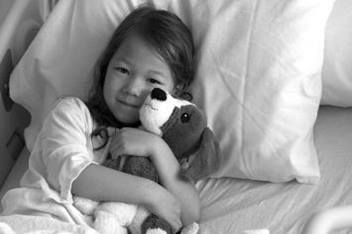Endoscopic Retrograde Cholangiopancreatography (ERCP)
What Is ERCP?
Endoscopic retrograde cholangiopancreatography (ERCP) is a procedure that can diagnose and treat problems in the pancreatic and bile ducts. Endoscopy means inserting a thin, flexible tube into your child’s mouth and down into the upper intestines. Cholangiopancreatography means using imaging to check the pancreas, pancreatic ducts, gallbladder, liver or bile ducts for problems such as narrowing or blockages. Retrograde refers to how the tube or tubes go in: backward, or against the flow of bile.
Once the problem, such as a gallstone or narrowed duct is found, the child can often be treated right away. The endoscopy allows the doctor to insert tools (such as a balloon or stent) to widen a narrow duct or remove a blockage.
Who May Benefit From ERCP?
Less invasive tests such as X-rays, ultrasound, CT scans or magnetic resonance imaging (MRI) first look for the cause of a child’s pain or digestive problems. ERCP is then used if the doctor expects to treat a problem found, such as:
- Pancreatitis: This causes severe stomach (abdominal) pain. ERCP can be used to take a better look at the pancreatic duct. A balloon can then be used to break apart scar tissue (a stricture) that has narrowed the pancreatic duct. Stones may be removed. A stent can keep the narrowed area more open as it heals.
- Jaundice: This causes yellowing of the skin or eyes because of a build-up of bilirubin in the blood. This may happen when there is a blockage or narrowing of the bile ducts in the liver, gallbladder or pancreas. ERCP can be used to clear the blockages or widen narrow ducts.
- Cysts or tumors. ERCP can help diagnose these problems.
- Pain or digestive issues with no known cause. ERCP can be used to find and treat problems that may be causing pain.
How Is ERCP Done?
Before the procedure, your child will have to avoid food and drink for a few hours. ERCP requires general anesthesia. This means your child is put to sleep using medicine. This keeps children comfortable. The endoscope will enter the mouth. It will pass down the esophagus, through the stomach to the upper intestine, where the gallbladder and pancreatic ducts empty into the intestine. Your child’s heart and oxygen levels will be monitored for the entire procedure by a skilled pediatric anesthesiologist. This is a doctor who specializes in giving anesthesia.
The endoscope allows the doctor to see inside your child’s gastrointestinal tract and duct openings using a tiny camera. It can then be used to inject a dye that shows up on X-rays. The X-rays can help find the exact location of the problem. The doctor can insert tools and devices to treat the problem area.
Treatment during an ERCP depends on the type of problem your child has. Treatments may include:
- Removing a gallstone. A balloon or basket-type tool is pushed past the stone. The doctor inflates or opens it and pulls it back. This brings the stone along until it is passed through to the intestines. If the stone is very large, the doctor may break it up with a laser or similar device (also inserted through the endoscope) before pulling it out.
- Widening a duct or opening a stricture. For ducts that are narrow, the doctor may use the endoscope to insert a balloon. As it is inflated, it widens the duct by stretching the scar tissue or duct walls. Because the balloon must then be removed, the doctor will typically insert a stent to keep the duct open wide as it heals in the new position.
- Placing a stent. The doctor will pass a small tube or straw, called a stent, into the duct. It can help hold narrow ducts open or support tissue as it heals. It can also stop duct leaks and allow ducts to heal safely if they have a tear. The stent will typically be removed during another ERCP procedure after a few weeks to a few months.
After evaluating and treating the problem, the doctor will take the endoscope out. Your child will wake up from the anesthesia. The entire procedure usually takes one to two hours.
The procedure itself is not painful. Few children may have a side effect from the ERCP that can cause pain or vomiting. These symptoms typically pass quickly, but your child may need to stay overnight in the hospital. The doctor or nurse will discuss your child’s results and care plan with you before you leave the hospital.
Why Nationwide Children’s?
Nationwide Children’s offers a full range of therapies for children with pancreas conditions.
Muhammad Khan, MD, MPH, FASGE, is a pediatric gastroenterologist and director of interventional and diagnostic endoscopy at Nationwide Children’s. Dr. Khan is trained and experienced in performing endoscopic retrograde cholangiopancreatography (ERCP) procedures in children.
Dr. Khan received additional training in interventional endoscopy to treat more children using less invasive strategies. His surgical skills include POEM, endoscopic ultrasound, pancreaticobiliary endoscopy and complex polyp resections. He is the only pediatric gastroenterologist in the United States performing all these interventional endoscopy procedures in pediatric patients.
Our team, combined with our state-of-the-art equipment and facilities, allow us to provide the highest level of care for our patients, ensuring that they receive the best possible outcomes from their procedure. We are committed to working closely with our patients to develop personalized treatment plans that meet their unique needs and help them achieve the best possible results.
Dr. Khan and the Pancreas and Liver Care Center team will evaluate your child and work with your family to design a care plan that offers your child the best chance at healing, comfort and good quality of life. Our team will be happy to answer any questions or schedule an appointment.



